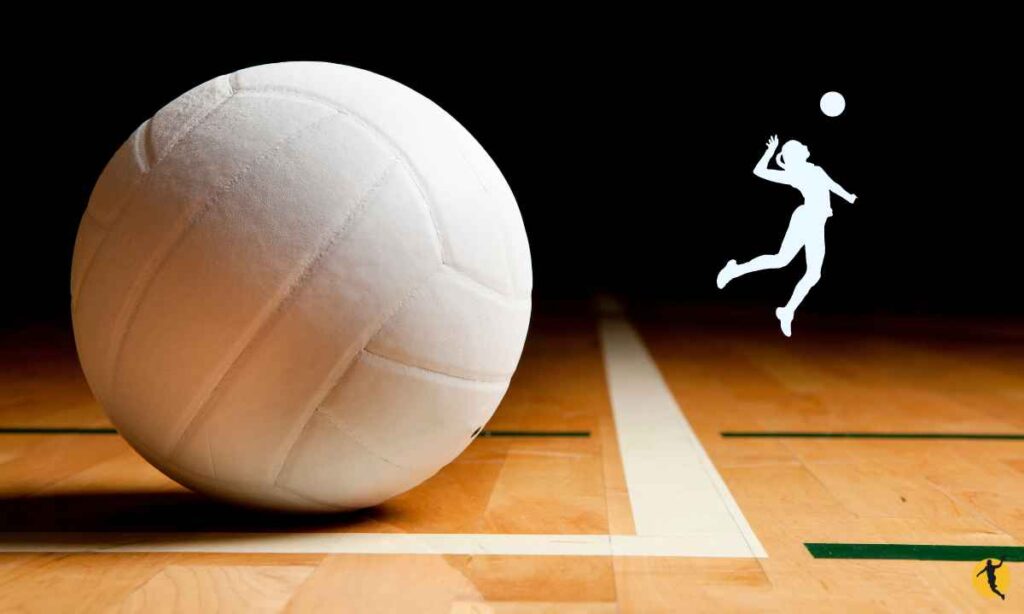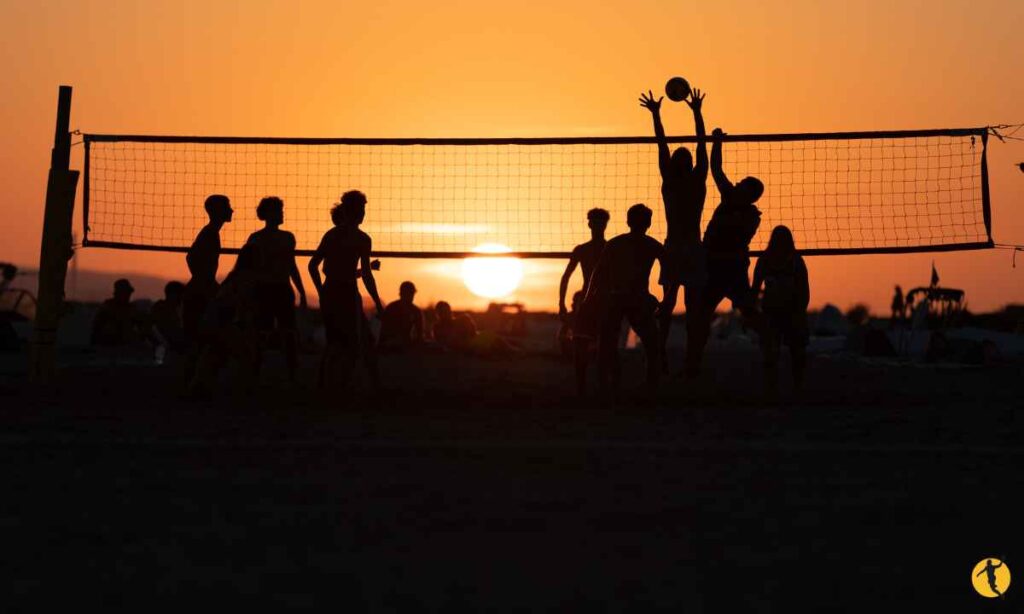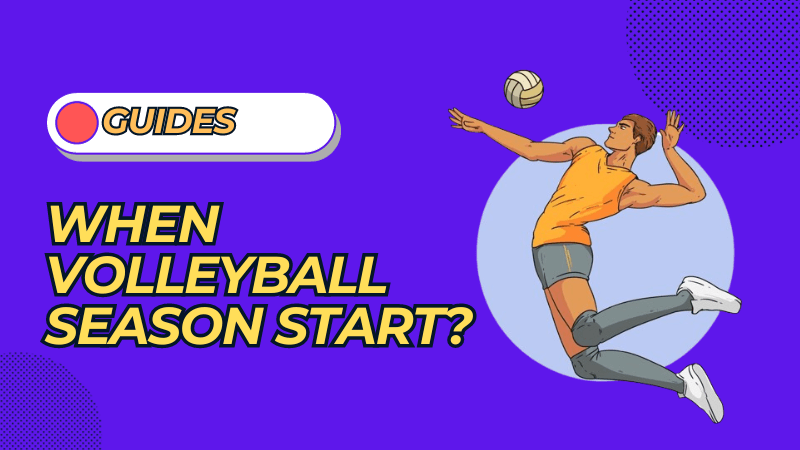Volleyball, a sport played passionately by over 800 million enthusiasts worldwide, thrives in the hearts of fans from Europe to South America and beyond. However, a constant question lingers in the minds of players, fans, and organizers: “When is volleyball season?”
The answer is complex and varies greatly depending on the level of play, region, and even the type of volleyball, whether it be beach, club, or professional. The high school season in the United States might start in August, while beach volleyball heats up in May. The uncertainty around the start and end of various volleyball seasons can cause confusion, making it essential to have a clear understanding for planning, training, and simply enjoying this captivating sport.
Whether you’re a player waiting for the next match or a fan eagerly awaiting the next spike, the volleyball season is worth exploring.
When Is Volleyball Season?
The volleyball season can be found all year round, with specific start and end dates varying depending on the level of play, location, and type of volleyball, such as beach, club, or professional. In the United States, for instance, high school volleyball usually starts in August or September and ends in November or December, while professional leagues might run at different times.
Understanding the intricacies of the volleyball season requires examining multiple factors. From local middle school leagues that may follow school district schedules to international competitions throughout the year, the timeline for volleyball is multifaceted.
Different regions, levels of competition, and even the choice between indoor and beach volleyball contribute to this diverse schedule. For fans and players alike, tracking the volleyball season is essential to staying connected to the game, whether you’re planning to watch the next big match or preparing for your own season.
What Is The Start Date Of The Volleyball Season: All Levels!

Continuing to unravel the complexity of the volleyball season, let’s delve into the specifics of the start dates across various levels and types of play. These details are vital for players, coaches, and enthusiasts who want to mark their calendars and ensure they’re ready for the action.
When Does Volleyball Season Start for High School?
The high school volleyball season’s start date varies depending on the state and region. In the United States, it typically begins in August or September and ends in November or December. Preseason training often starts earlier, allowing teams to prepare for the competition.
When Does Middle School Volleyball Season Start?
The start of the middle school volleyball season may differ by school district and region. Usually coinciding with the academic year, middle school volleyball kicks off in late August or early September.
When Does Club Volleyball Season Start?
Club volleyball seasons last 6-9 months and usually include at least 15 games and 3-5 tournaments. The specific start dates might vary based on location and league regulations.
When Does College Volleyball Season Start?
College and university volleyball seasons typically last four to five months in the United States, with the regular season including 10-15 games. The season usually commences in lanuary at the beginning of the semester and ends in April or May.
When Is the International Volleyball Season?
International volleyball competitions take place all year round, with various leagues and tournaments occurring across different countries and continents.
When Does Professional Volleyball Season Start?
Professional volleyball competitions also happen throughout the year, with specific league seasons depending on the country, continent, and particular organization.
When Does Beach Volleyball Season Start?
Beach volleyball season in the United States typically runs from May to September. The timing aligns with warmer weather, allowing for outdoor play on sandy beaches.
When Does Snow Volleyball Season Start?
Snow volleyball season typically takes place from December to March in the Northern Hemisphere. As a winter variation of the game, it’s played on snow and offers a unique twist to the traditional sport.
By understanding these variations in start dates, anyone involved in volleyball can plan, prepare, and participate in this exhilarating sport’s vibrant and diverse world.
Is volleyball played at different times in different countries?

Yes, volleyball is played at different times in different countries, reflecting this captivating sport’s diversity and global appeal. This variety is shaped by factors such as climate, culture, professional leagues, and local traditions.
In countries with varying seasons, like the United States, the indoor volleyball season might start in the late summer and extend into winter. In contrast, beach volleyball capitalizes on the warmer months, from May to September. On the other hand, snow volleyball in the Northern Hemisphere takes advantage of the snowy conditions from December to March.
Internationally, professional leagues have different schedules depending on the country and continent. For instance, the FIVB Volleyball Nations League runs from May to July, while the CEV Champions League extends from October to May.
Such differences are not merely logistical but add to the richness and excitement of the game. They ensure that volleyball enthusiasts can find matches, leagues, and tournaments to follow, participate in, or enjoy almost any time of the year, regardless of where they are.
By acknowledging and embracing these variations, volleyball maintains its status as one of the most accessible and well-loved sports on the planet, providing endless opportunities for players and fans alike. Whether it’s indoor, beach, snow, or professional volleyball, there’s always a game happening somewhere, keeping the spirit and energy of volleyball alive and thriving year-round.
How Long Is a Volleyball Season?
The length of a volleyball season can be as varied and dynamic as the game itself. While we have touched upon the start and end dates in previous sections, it’s worth delving into how long a volleyball season lasts, as it greatly varies depending on the level of play and location.
- High School and Middle School Volleyball Season: These seasons usually last a few months, typically starting in August or September and ending in November or December in the United States.
- Club Volleyball Season: Club seasons are more extended, lasting between 6-9 months, and usually include at least 15 games and 3-5 tournaments.
- College Volleyball Season: The college and university seasons typically last four to five months, encompassing 10-15 games in the regular season.
- International Volleyball Season: International competitions can occur all year round, with specific tournaments and leagues having defined durations.
- Professional Volleyball Season: Like international volleyball, professional competitions take place all year round, depending on the specific league and country.
- Beach Volleyball Season: In the United States, beach volleyball usually runs from May to September.
- Snow Volleyball Season: Snow volleyball in the Northern Hemisphere typically runs from December to March.
- Length of a Game: It’s also worth noting that the average volleyball game lasts 60 to 90 minutes, depending on how many sets are played.
Considering all these varying factors, we can see that the question, “How Long Is a Volleyball Season?” doesn’t have a straightforward answer. The season’s length reflects the sport’s multifaceted nature, which can accommodate different climates, playing levels, and formats. Whether you’re a player, coach, or fan, understanding these nuances ensures you can plan accordingly and make the most of each vibrant and exciting volleyball season.
When Does Volleyball Season End?

While we’ve explored the rich tapestry of volleyball’s season starts, let’s turn our focus to the other side of the net – the season’s end. Similar to the start dates, the end of the volleyball season fluctuates depending on various factors, including the level of play, location, and specific leagues or tournaments. Here’s a closer look:
- High School Volleyball Season: In the United States, high school volleyball season usually wraps up in November or December.
- Middle School Volleyball Season: Like high school, middle school seasons typically conclude around the same time.
- Club Volleyball Season: Club seasons might extend further, possibly lasting 6-9 months, depending on the location, and could include various games and tournaments.
- College Volleyball Season: The college season may stretch into January, culminating with national championships.
- International Volleyball Season: International competitions occur all year round, so they don’t have a set end date. Each tournament or league will have its specific concluding timeframe.
- Professional Volleyball Season: Professional volleyball leagues also follow diverse schedules, with different end dates depending on the country and specific league.
- Beach Volleyball Season: In the United States, the beach volleyball season typically concludes in September.
- Snow Volleyball Season: Snow volleyball season generally ends in March in the Northern Hemisphere.
Understanding when the volleyball season ends is crucial for players, coaches, fans, and organizers alike. Whether preparing for the next game or planning a celebratory end-of-season gathering, recognizing the distinctive end dates across various volleyball domains helps to ensure a fulfilling and well-coordinated experience. It’s all part of the sport’s unique appeal, offering different ways to engage, compete, and enjoy the game all year long.
Also, Read: Volleyball Tips for Beginners
Conclusion
Volleyball is a fascinating sport that captivates millions around the globe. With a season that varies across different levels of play and locations, it’s a game that can be enjoyed all year round.
The sport offers a rich diversity, from high school and college competitions to professional leagues and unique formats like beach and snow volleyball. In the United States alone, high school participation in volleyball has grown by over 10% from 2010 to 2019, reflecting the sport’s increasing popularity.
Whether you’re watching the action-packed FIVB Volleyball Nations League or playing in a local club, understanding the different seasons and schedules adds to the game’s enjoyment. Volleyball continues to be a sport that unites, excites, and provides endless opportunities for both recreation and competition.
FAQS:
Does Volleyball Have a Season?
Yes, volleyball does have a season. The timing of the season varies based on the level of play, location, and specific leagues or tournaments. Whether it’s high school, college, professional, or beach volleyball, each has its unique schedule.
What Months Do You Play Volleyball?
Volleyball can be played all year round at different levels of play. High school and college seasons might run from August or September to January, while beach and snow volleyball have specific seasonal windows. Professional and international competitions take place throughout the year.
What Seasonal Sport Is Volleyball?
Volleyball is considered a seasonal sport, but it’s played all year round at various levels of play. From high school and college competitions to professional leagues and international tournaments, volleyball offers something for every season.
How Many Months Does Volleyball Last?
The length of a volleyball season varies depending on the level of play and location. High school and college seasons might last four to five months, while club seasons might extend 6-9 months. Professional and international competitions can take place throughout the year.
How Many Games Are in a Volleyball Season?
The number of games in a volleyball season varies based on the level of play and location. High school and college seasons might include 10-15 regular-season games, while club seasons usually consist of at least 15 games and 3-5 tournaments.

